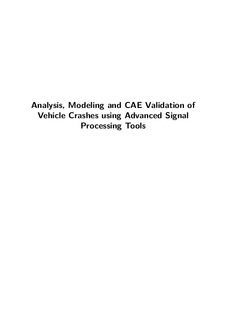| dc.description.abstract | Road safety is one of the hot-spot issues in modern society and covers many aspects
of traffic system. Vehicle safety plays an important role in reducing the casualties and
saving the accident cost. Up to now, a lot of efforts have been made to improve vehicle
safety on both passive and active aspects, such as optimizing the vehicle structure,
updating the vehicle dynamic control algorithm and developing driving assistant system.
Considering the fact that traffic accidents cannot be completely avoided, passive safety
of vehicle are seriously concerned by researchers, manufactures and consumers.
Modeling of vehicle crash process is a challenging problem, which has been widely
studied and will remain a topic of interest in the future. With the developing of Computer
Aided Engineering (CAE) technology (e.g. multi-body theory, nonlinear finite
element method), detailed numerical models are used in various areas of vehicle safety.
However, the development and utilization of numerical models are generally time consuming
and costly. At the same time, mathematical models are usually built without
clear physical interpretation, although they have advantages in some applications. The
existing mathematical models have limitations in adaptation to different crash conditions.
This thesis is mainly about the investigation of vehicle crash process based on the
time-frequency analysis of the crash responses (i.e. the accelerations of vehicle structure).
The essential idea of this work is to building the mathematical relationship
between vehicle structures and crash responses. The data used in this work come from
the NCAP crash tests and finite element crash simulations of Toyota Yaris. Paper A
illustrates the typical load paths of vehicle frontal structure firstly. According to the
energy absorbing features of crashworthiness components, a piecewise model is proposed
to represent frontal crashes. The proposed model is built by analyzing the crash
response, engine accelerations and external barrier force. Moreover, the model variance
in different cases, including crashes with different impact velocities and oblique crashes,
are also discussed. Papers B and C introduce Ensemble Empirical Mode Decomposition
(EEMD) method into crash response analyzing. EEMD is a time-frequency analysis
technology, which is suitable for nonlinear and non-stationary signals. Paper B studies
the signal transmission in vehicle components and illustrates how the deformations of
components influence the crash responses. Paper C proposes an integrated algorithm
to identify the performance of energy absorbing components during crashes by both
low frequency trend and high frequency oscillations of the response signal. Two cases,
low speed crash and oblique crash, are also studied in this work. Paper D presents
a modeling scheme of vehicle crash, as well as an estimation method of crashes with
different velocities. Specifically, the parameters of proposed model are identified from the data of corresponding NCAP 56km/h frontal crash test, which is available for
most vehicles. For the crash process estimation, the crashes are catalogued into light,
moderate and sever types, according to the deformed components. For the crashes in
different catalogues, the structures and parameters of piecewise models may vary consequently.
For this reason, the estimation algorithms of three types of car crashes are
developed separately. Examples are also given for these three cases. Finally, Paper E
discusses the application of EEMD in the validation of CAE simulations. The proposed
scheme compares the trend and oscillations of original signal separately and involves
more features to achieve better validation performance.
In conclusion, this thesis involves the signal processing technologies into the analysis,
modeling and CAE model validation of vehicle frontal crashes. It benefits the understanding
of vehicle crash processes and helps to achieve better safety design of vehicle.
Some future work should be continued for car crashes in more complex conditions. | nb_NO |
